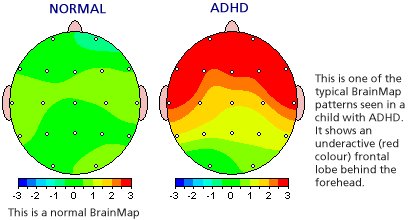Electroencephalography (EEG) is the measurement of electrical patterns at the surface of the scalp which reflect cortical activity, and are commonly referred to as “brainwaves”. Quantitative EEG (qEEG) is the analysis of the digitized EEG, and in lay terms this sometimes is also called “Brain Mapping”. The qEEG is an extension of the analysis of the visual EEG interpretation which may assist and even augment our understanding of the EEG and brain function.
Quantitative Electroencephalography (qEEG) is a procedure that processes the recorded EEG activity from a multi-electrode recording using a computer. This multi-channel EEG data is processed with various algorithms, such as the “Fourier” classically, or in more modern applications “Wavelet” analysis). The digital data is statistically analyzed, sometimes comparing values with “normative” database reference values. The processed EEG is commonly converted into color maps of brain functioning called “Brain maps”.
The EEG and the derived qEEG information can be interpreted and used by experts as a clinical tool to evaluate brain function, and to track the changes in brain function due to various interventions such as neurofeedback or medication.
Quantitative Electroencephalography (qEEG) processing techniques and the use of modern analytic software to processes the EEG/qEEG gives us the ability to view the dynamic changes taking place throughout the brain during cognitive processing tasks, and this novel approach can be used to assist us in determining which areas of the brain are engaged and processing efficiently.
Various analytic approaches exist, from commercial databases to database free approaches, such as EEG phenotype analysis or the more classic European Vigilance model of Bente (1964) are used in modern clinical application of the EEG/qEEG. The use of advanced techniques such as Independent Component Analysis (ICA) and neuro-imaging techniques such as Low Resolution Electromagnetic Tomography (LORETA) can map the actual sources of the cortical rhythms. These advanced approaches are changing our understanding of the dynamics and function of the human brain.





